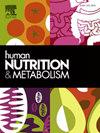Associations and interactions of clinical and genetic variables for type 2 diabetes mellitus in the mexican population
IF 1.8
Q3 ENDOCRINOLOGY & METABOLISM
引用次数: 0
Abstract
Type 2 diabetes mellitus (T2DM) is a chronic metabolic disorder characterized by high blood sugar levels (hyperglycemia).
It is among the top ten causes of death worldwide and involves non-modifiable (genetic risk variants) and modifiable factors (BMI, triglycerides and cholesterol).
Methods
We included 199 subjects with T2DM and 213 subjects without T2DM, both groups of the Mexican population. Genotyping was determined using real-time PCR with TaqMan probes. We determined the associations and interactions of clinical and genetic variables for T2DM in the Mexican population using Multifactor-Dimensionality Reduction (MDR; Version 3.0.2).
Results
The polymorphisms showed a strong association with the risk of suffering from T2DM when they occur additively and the interaction between clinical and genetic variables explains much of the weight of both factors in the etiology of the disease.
Conclusion
The associations and interactions show that, regarding the risk of T2DM in this population, the most crucial is a BMI >24.9 kg/m2, followed by triglycerides >150 mg/dL and cholesterol <200 mg/dL; after this, ranked in importance for the risk of T2DM, are genetic polymorphisms in LEP, LEPR, FTO, and ADIPOQ in Mexican population.
墨西哥人群中2型糖尿病的临床和遗传变量的关联和相互作用
2型糖尿病(T2DM)是一种以高血糖(高血糖)为特征的慢性代谢性疾病。它是全世界十大死亡原因之一,涉及不可改变(遗传风险变异)和可改变的因素(体重指数、甘油三酯和胆固醇)。方法我们纳入199例T2DM患者和213例非T2DM患者,两组均为墨西哥人群。采用TaqMan探针进行实时PCR分型。我们使用多因素降维法(MDR;3.0.2版本)。结果当多态性叠加发生时,它们与患2型糖尿病的风险密切相关,临床和遗传变量之间的相互作用解释了这两个因素在该疾病病因学中的重要作用。结论上述相关性和相互作用表明,在该人群中,最重要的T2DM风险是BMI = 24.9 kg/m2,其次是甘油三酯= 150 mg/dL和胆固醇= 200 mg/dL;在此之后,墨西哥人群中LEP、LEPR、FTO和ADIPOQ的遗传多态性对2型糖尿病的风险排序为重要。
本文章由计算机程序翻译,如有差异,请以英文原文为准。
求助全文
约1分钟内获得全文
求助全文
来源期刊

Human Nutrition and Metabolism
Agricultural and Biological Sciences-Food Science
CiteScore
1.50
自引率
0.00%
发文量
30
审稿时长
188 days
 求助内容:
求助内容: 应助结果提醒方式:
应助结果提醒方式:


